Episodic Sedimentary Evolution of an Alluvial Fan (Huangshui Catchment, NE Tibetan Plateau)
Abstract
:1. Introduction
2. Geographical Setting
3. Methods
3.1. Field Work
3.2. Grain-Size Measurements
3.3. Optically Stimulated Luminescence Dating
4. Results
4.1. Facies Analysis and Grain-Size Analysis
4.1.1. High-Energy Alluvial Fan (Facies Association 1)
Description
Interpretation
4.1.2. Low-Energy Alluvial Fan (Facies Association 2)
Description
OSL- and Grain-Size Analyses
Interpretation
4.1.3. Floodplain (Facies Association 3)
Description
Interpretation
4.2. Dating Results
5. Discussion
5.1. Origin of Stacked Sand Mounds, and the Interaction of Aeolian and Alluvial Process
5.2. Alluvial-Fan Process and Links to Autogenic Models and Exterior Controls (Climate and Tectonics)
6. Conclusions
Author Contributions
Funding
Acknowledgments
Conflicts of Interest
References
- Mather, A.E.; Stokes, M.; Whitfield, E. River terraces and alluvial fans: The case for an integrated Quaternary fluvial archive. Quat. Sci. Rev. 2017, 166, 74–90. [Google Scholar] [CrossRef]
- An, Z.; Kukla, G.; Porter, S.C.; Xiao, J. Late Quaternary dust flow on the Chinese loess plateau. Catena 1991, 18, 125–132. [Google Scholar] [CrossRef]
- Ding, Z.; Liu, T.; Rutter, N.W.; Yu, Z.; Guo, Z.; Zhu, R. Ice-volume forcing of East Asian winter monsoon variations in the past 800,000 years. Quat. Res. 1995, 44, 149–159. [Google Scholar] [CrossRef]
- Long, H.; Shen, J.; Chen, J.; Tsukamoto, S.; Yang, L.; Cheng, H.; Frechen, M. Holocene moisture variations over the semiarid-arid central Asia revealed by a comprehensive sand-dune record from the central Tian Shan, NW China. Quat. Sci. Rev. 2017, 174, 13–32. [Google Scholar] [CrossRef]
- Prins, M.A.; Vriend, M.; Nugteren, G.; Vandenberghe, J.; Lu, H.; Zheng, H.; Jan Weltje, G. Late Quaternary aeolian dust input variability on the Chinese Loess Plateau: Inferences from unmixing of loess grain-size records. Quat. Sci. Rev. 2007, 26, 230–242. [Google Scholar] [CrossRef]
- Sun, Y.; Chen, J.; Clemens, S.C.; Liu, Q.; Ji, J.; Tada, R. East Asian monsoon variability over the last seven glacial cycles recorded by a loess sequence from the northwestern Chinese Loess Plateau. Geochem. Geophs. Geosyst. 2006, 7. [Google Scholar] [CrossRef] [Green Version]
- Wu, Y.; Qiu, S.; Fu, S.; Rao, Z.; Zhu, Z. Pleistocene climate change inferred from multi-proxy analyses of a loess-paleosol sequence in China. J. Asian Earth Sci. 2018, 154, 428–434. [Google Scholar] [CrossRef]
- Zhang, W.; Lu, H.; Li, C.; Dodson, J.; Meng, X. Pollen preservation and its potential influence on paleoenvironmental reconstruction in Chinese loess deposits. Rev. Palaeobot. Palynol. 2017, 240, 1–10. [Google Scholar] [CrossRef]
- Long, H.; Shen, J.; Wang, Y.; Gao, L.; Frechen, M. High resolution OSL dating of a late Quaternary sequence from Xingkai Lake (NE Asia): Chronological challenge of the “MIS3a Mega-paleolake” hypothesis in China. Earth Planet. Sci. Lett. 2015, 428, 281–292. [Google Scholar] [CrossRef]
- Xu, H.; Ai, L.; Tan, L.; An, Z. Stable isotopes in bulk carbonates and organic matter in recent sediments of Lake Qinghai and their climatic implications. Chem. Geol. 2006, 235, 262–275. [Google Scholar] [CrossRef]
- Xiao, J.; Chang, Z.; Si, B.; Qin, X.; Itoh, S.; Lomtatidze, Z. Partitioning of the grain-size components of Dali Lake core sediments: Evidence for lake-level changes during the Holocene. J. Paleolimnol. 2009, 42, 249–260. [Google Scholar] [CrossRef]
- Wang, R.; Zhang, Y.; Wünnemann, B.; Biskaborn, B.K.; Yin, H.; Xia, F.; Zhou, L.; Diekmann, B. Linkages between Quaternary climate change and sedimentary processes in Hala Lake, northern Tibetan Plateau, China. J. Asian Earth Sci. 2015, 107, 140–150. [Google Scholar] [CrossRef]
- Liu, X.; Vandenberghe, J.; An, Z.; Li, Y.; Jin, Z.; Dong, J.; Sun, Y. Grain size of Lake Qinghai sediments: Implications for riverine input and Holocene monsoon variability. Palaeogeogr. Palaeoclimatol. Palaeoecol. 2016, 449, 41–51. [Google Scholar] [CrossRef] [Green Version]
- Wang, X.; Vandenberghe, D.; Yi, S.; Vandenberghe, J.; Lu, H.; Balen, R.V. Late Quaternary paleoclimatic and geomorphological evolution at the interface between the Menyuan basin and the Qilian Mountains, northeastern Tibetan Plateau. Quat. Res. 2013, 80, 534–544. [Google Scholar] [CrossRef] [Green Version]
- Li, G.; Dong, G.; Wen, L.; Chen, F. Overbank flooding and human occupation of the Shalongka site in the Upper Yellow River Valley, northeast Tibet Plateau in relation to climate change since the last deglaciation. Quat. Res. 2014, 82, 354–365. [Google Scholar] [CrossRef]
- Wang, X.; Vandenberghe, J.; Yi, S.; Van Balen, R.; Lu, H. Climate-dependent fluvial architecture and processes on a suborbital timescale in areas of rapid tectonic uplift: An example from the NE Tibetan Plateau. Glob. Planet. Chang. 2015, 133, 318–329. [Google Scholar] [CrossRef]
- Harvey, A.M.; Mather, A.E.; Stokes, M. Alluvial fans: Geomorphology, sedimentology, dynamics—Introduction. A review of alluvial-fan research. In Alluvial Fans: Geomorphology, Sedimentology, Dynamics; Harvey, A.M., Mather, A.E., Stokes, M., Eds.; Geological Society: London, UK, 2005; pp. 1–7. ISBN 1-86239-189-0. [Google Scholar]
- Vandenberghe, J. Timescales, climate and river development. Quat. Sci. Rev. 1995, 14, 631–638. [Google Scholar] [CrossRef]
- Vandenberghe, J. Climate forcing of fluvial system development: An evolution of ideas. Quat. Sci. Rev. 2003, 22, 2053–2060. [Google Scholar] [CrossRef]
- Bridgland, D.R. The record from British Quaternary river systems within the context of global fluvial archives. J. Quat. Sci. 2010, 25, 433–446. [Google Scholar] [CrossRef]
- Vandenberghe, J. River terraces as a response to climatic forcing: Formation processes, sedimentary characteristics and sites for human occupation. Quat. Int. 2015, 370, 3–11. [Google Scholar] [CrossRef]
- Hollands, C.B.; Nanson, G.C.; Jones, B.G.; Bristow, C.S.; Price, D.M.; Pietsch, T.J. Aeolian–fluvial interaction: Evidence for Late Quaternary channel change and wind-rift linear dune formation in the northwestern Simpson Desert, Australia. Quat. Sci. Rev. 2006, 25, 142–162. [Google Scholar] [CrossRef]
- Belnap, J.; Munson, S.M.; Field, J.P. Aeolian and fluvial processes in dryland regions: The need for integrated studies. Ecohydrology 2011, 4, 615–622. [Google Scholar] [CrossRef]
- Williams, M. Interactions between fluvial and eolian geomorphic systems and processes: Examples from the Sahara and Australia. Catena 2015, 134, 4–13. [Google Scholar] [CrossRef]
- Han, G.; Zhang, G.; You, L.; Wang, Y.; Yang, L.; Yang, J.; Zhou, L.; Yuan, M.; Zou, X.; Cheng, H. Deflated rims along the Xiangshui River on the Xiliaohe Plain, Northeast China: A case of active fluvial–aeolian interactions. Geomorphology 2016, 257, 47–56. [Google Scholar] [CrossRef]
- Wang, X.; Ma, J.; Yi, S.; Vandenberghe, J.; Dai, Y.; Lu, H. Interaction of fluvial and aeolian sedimentation processes and response to climate change since the last glacial in a semi-arid environment along the Yellow River. Quat. Res. 2018. [Google Scholar] [CrossRef]
- Armitage, J.J.; Duller, R.A.; Whittaker, A.C.; Allen, P.A. Transformation of tectonic and climatic signals from source to sedimentary archive. Nat. Geosci. 2011, 4, 231–235. [Google Scholar] [CrossRef]
- Stokes, M.; Cunha, P.P.; Martins, A.A. Techniques for analysing Late Cenozoic river terrace sequences. Geomorphology 2012, 165–166, 1–6. [Google Scholar] [CrossRef]
- Allen, P.A.; Armitage, J.J.; Carter, A.; Duller, R.A.; Michael, N.A.; Sinclair, H.D.; Whitchurch, A.L.; Whittaker, A.C. The Qs problem: Sediment volumetric balance of proximal foreland basin systems. Sedimentology 2013, 60, 102–130. [Google Scholar] [CrossRef]
- Chen, L.; Steel, R.J.; Guo, F.; Olariu, C.; Gong, C. Alluvial fan facies of the Yongchong Basin: Implications for tectonic and paleoclimatic changes during Late Cretaceous in SE China. J. Asian Earth Sci. 2017, 134, 37–54. [Google Scholar] [CrossRef]
- Ritter, J.B.; Miller, J.R.; Enzel, Y.; Wells, S.G. Reconciling the Roles of Tectonism and Climate in Quaternary Alluvial Fan Evolution. Geology 1995, 23, 245–248. [Google Scholar] [CrossRef]
- Harvey, A.M.; Silva, P.G.; Mather, A.E.; Goy, J.L.; Stokes, M.; Zazo, C. The impact of Quaternary sea-level and climatic change on coastal alluvial fans in the Cabo de Gata ranges, southeast Spain. Geomorphology 1999, 28, 1–22. [Google Scholar] [CrossRef]
- Hartley, A.J.; Mather, A.E.; Jolley, E.J.; Turner, P. Climatic controls on alluvial-fan activity, Coastal Cordillera, northern Chile. In Alluvial Fans: Geomorphology, Sedimentology, Dynamics; Harvey, A.M., Mather, A.E., Stokes, M., Eds.; Geological Society: London, UK, 2005; pp. 95–116. ISBN 1-86239-189-0. [Google Scholar]
- Waters, J.V.; Jones, S.J.; Armstrong, H.A. Climatic controls on late Pleistocene alluvial fans, Cyprus. Geomorphology 2010, 115, 228–251. [Google Scholar] [CrossRef]
- Frostick, L.E.; Reid, I.A.N. Climatic versus tectonic controls of fan sequences: Lessons from the Dead Sea, Israel. J. Geol. Soc. 1989, 146, 527–538. [Google Scholar] [CrossRef]
- Jolley, E.J.; Turner, P.; Willams, G.D.; Hartley, A.J.; Flint, S. Sedimentological response of an alluvial system to Neogene thrust tectonics, Atacama Desert, northern Chile. J. Geol. Soc. 1990, 147, 769–784. [Google Scholar] [CrossRef]
- Sinha, R.; Ahmad, J.; Gaurav, K.; Morin, G. Shallow subsurface stratigraphy and alluvial architecture of the Kosi and Gandak megafans in the Himalayan foreland basin, India. Sediment. Geol. 2014, 301, 133–149. [Google Scholar] [CrossRef]
- Stokes, M.; Mather, A.E. Controls on modern tributary-junction alluvial fan occurrence and morphology: High Atlas Mountains, Morocco. Geomorphology 2015, 248, 344–362. [Google Scholar] [CrossRef]
- Horton, B.K.; Decelles, P.G. Modern and ancient fluvial megafans in the foreland basin system of the central Andes, southern Bolivia: Implications for drainage network evolution in fold-thrust belts. Basin Res. 2001, 13, 43–63. [Google Scholar] [CrossRef]
- Arzani, N. The fluvial megafan of Abarkoh Basin (Central Iran): An example of flash-flood sedimentation in arid lands. In Alluvial Fans: Geomorphology, Sedimentology, Dynamics; Harvey, A.M., Mather, A.E., Stokes, M., Eds.; Geological Society: London, UK, 2005; pp. 41–59. ISBN 1-86239-189-0. [Google Scholar]
- Hoorn, C.; Straathof, J.; Abels, H.A.; Xu, Y.; Utescher, T.; Dupont-Nivet, G. A late Eocene palynological record of climate change and Tibetan Plateau uplift Xining basin, China. Palaeogeogr. Palaeoclimatol. Palaeoecol. 2012, 344–345, 16–38. [Google Scholar] [CrossRef]
- Chi, Y.; Fang, X.; Song, C.; Miao, Y.; Teng, X.; Han, W.; Wu, F.; Yang, J. Cenozoic organic carbon isotope and pollen records from the Xining basin, NE Tibetan Plateau, and their palaeoenvironmental significance. Palaeogeogr. Palaeoclimatol. Palaeoecol. 2013, 386, 436–444. [Google Scholar] [CrossRef]
- Zhang, C.; Guo, Z. Clay mineral changes across the Eocene–Oligocene transition in the sedimentary sequence at Xining occurred prior to global cooling. Palaeogeogr. Palaeoclimatol. Palaeoecol. 2014, 411, 18–29. [Google Scholar] [CrossRef]
- Zan, J.; Fang, X.; Yan, M.; Zhang, W.; Lu, Y. Lithologic and rock magnetic evidence for the Mid-Miocene Climatic Optimum recorded in the sedimentary archive of the Xining basin, NE Tibetan Plateau. Palaeogeogr. Palaeoclimatol. Palaeoecol. 2015, 431, 6–14. [Google Scholar] [CrossRef]
- Vandenberghe, J.; Wang, X.; Lu, H. Differential impact of small-scaled tectonic movements on fluvial morphology and sedimentology the Huang Shui catchment, NE Tibet Plateau. Geomorphology 2011, 134, 171–185. [Google Scholar] [CrossRef]
- Wang, X.; Lu, H.; Vandenberghe, J.; Zheng, S.; Balen, R.V. Late Miocene uplift of the NE Tibetan Plateau inferred from basin filling, planation and fluvial terraces in the Huang Shui catchment. Glob. Planet. Chang. 2012, 88–89, 10–19. [Google Scholar] [CrossRef]
- Wu, Q.; Zhao, Z.; Liu, L.; Granger, D.E.; Wang, H.; Cohen, D.J.; Wu, X.; Ye, M.; Bar-Yosef, O.; Zhang, J.; et al. Outburst flood at 1920 BCE supports historicity of China’s Great Flood and the Xia dynasty. Science 2016, 353, 579–582. [Google Scholar] [CrossRef] [PubMed]
- Wang, X.; Vandenberghe, J.; Lu, H.; Balen, R.V. Climatic and tectonic controls on the fluvial morphology of the Northeastern Tibetan Plateau China. J. Geogr. Sci. 2017, 27, 1325–1340. [Google Scholar] [CrossRef]
- Lu, H.; Wang, X.; Sun, X.; Wang, X.; Yi, S.; Zhou, Y.; Liu, Q. Loess stratigraphy and palaeoclimate changes during Quaternary in northeastern Tibetan Plateau revealed by loess core. Quat. Res. 2007, 27, 230–241, (In Chinese with English Abstract). [Google Scholar]
- An, Z.; Colman, S.M.; Zhou, W.; Li, X.; Brown, E.T.; Jull, A.J.T.; Cai, Y.; Huang, Y.; Lu, X.; Chang, H.; et al. Interplay between the Westerlies and Asian monsoon recorded in Lake Qinghai sediments since 32 ka. Sci. Rep.UK 2012, 2, 619. [Google Scholar] [CrossRef] [PubMed] [Green Version]
- Vandenberghe, J.; Renssen, H.; Van Huissteden, K.; Nugteren, G.; Konert, M.; Lu, H.; Dodonov, A.; Buylaert, J. Penetration of Atlantic westerly winds into Central and East Asia. Quat. Sci. Rev. 2006, 25, 2380–2389. [Google Scholar] [CrossRef]
- Henderson, A.C.G.; Holmes, J.A.; Leng, M.J. Late Holocene isotope hydrology of Lake Qinghai, NE Tibetan Plateau: Effective moisture variability and atmospheric circulation changes. Quat. Sci. Rev. 2010, 29, 2215–2223. [Google Scholar] [CrossRef]
- Zhang, J.; Ma, Z.; Li, Z.; Li, W. Study on Deformational Characteristics of Northeastern Qinghai-Xizang (Tibetan) Plateau from Late Cenzoic Defomation in the Xining basin. Geol. Rev. 2009, 55, 457–472, (In Chinese with English Abstract). [Google Scholar]
- Miall, A.D. The Geology of Fluvial Deposits: Sedimentary Facies, Basin Analysis, and Petroleum Geology; Springer: Berlin/Heidelberg, Germany, 1996; ISBN 3-540-59186-9. [Google Scholar]
- Konert, M.; Vandenberghe, J. Comparison of laser grain size analysis with pipette and sieve analysis: A solution for the underestimation of the clay fraction. Sedimentology 1997, 44, 523–535. [Google Scholar] [CrossRef]
- Murray, A.S.; Wintle, A.G. Luminescence dating of quartz using an improved single-aliquot regenerative-dose protocol. Radiat. Meas. 2000, 32, 57–73. [Google Scholar] [CrossRef]
- Murray, A.S.; Wintle, A.G. The single aliquot regenerative dose protocol: Potential for improvements in reliability. Radiat. Meas. 2003, 37, 377–381. [Google Scholar] [CrossRef]
- Thiel, C.; Buylaert, J.; Murray, A.; Terhorst, B.; Hofer, I.; Tsukamoto, S.; Frechen, M. Luminescence dating of the Stratzing loess profile (Austria)–Testing the potential of an elevated temperature post-IR IRSL protocol. Quat. Int. 2011, 234, 23–31. [Google Scholar] [CrossRef]
- Wintle, A.G. Luminescence dating: Where it has been and where it is going. Boreas 2008, 37, 471–482. [Google Scholar] [CrossRef]
- Buylaert, J.P.; Jain, M.; Murray, A.S.; Thomsen, K.J.; Thiel, C.; Sohbati, R. A robust feldspar luminescence dating method for Middle and Late Pleistocene sediments. Boreas 2012, 41, 435–451. [Google Scholar] [CrossRef]
- Li, B.; Li, S. A reply to the comments by Thomsen et al. on “Luminescence dating of K-feldspar from sediments: A protocol without anomalous fading correction”. Quat. Geochronol. 2012, 8, 49–51. [Google Scholar] [CrossRef]
- Yi, S.; Buylaert, J.; Murray, A.S.; Lu, H.; Thiel, C.; Zeng, L. A detailed post-IR IRSL dating study of the Niuyangzigou loess site in northeastern China. Boreas 2016, 45, 644–657. [Google Scholar] [CrossRef] [Green Version]
- Guérin, G.; Mercier, N.; Adamiec, G. Dose-rate conversion factors: Update. Ancient TL 2011, 29, 5–8. [Google Scholar]
- Mejdahl, V. Thermoluminescence Dating: Beta-dose attenuation in quartz grains. Archoeometry 1979, 21, 61–79. [Google Scholar] [CrossRef]
- Huntley, D.J.; Baril, M.R. The K content of the K-feldspars being measured in optical dating or in thermoluminescence dating. Ancient TL 1997, 15, 11–13. [Google Scholar]
- Mejdahl, V. Internal radioactivity in quartz and feldspar grains. Ancient TL 1987, 5, 10–17. [Google Scholar]
- Zhao, H.; Li, S. Internal dose rate to K-feldspar grains from radioactive elements other than potassium. Radiat. Meas. 2005, 40, 84–93. [Google Scholar] [CrossRef]
- Vandenberghe, D.; De Corte, F.; Buylaert, J.P.; Kučera, J. On the internal radioactivity in quartz. Radiat. Meas. 2008, 43, 771–775. [Google Scholar] [CrossRef]
- Einsele, G. Sedimentary Basins: Evolution, Facies, and Sediment Budget; Springer: Berlin/Heidelberg, Germany, 2000; ISBN 3-540-66193-X. [Google Scholar]
- Brierley, G.J.; Liu, K.; Crook, K.A.W. Sedimentology of coarse-grained alluvial fans in the Markham Valley, Papua New Guinea. Sediment. Geol. 1993, 86, 297–324. [Google Scholar] [CrossRef]
- Todd, S.P. Stream-driven, high-density gravelly traction carpets: Possible deposits in the Trabeg. Sedimentology 1989, 36, 513–530. [Google Scholar] [CrossRef]
- Jo, H.R.; Rhee, C.W.; Chough, S.K. Distinctive characteristics of a streamflow-dominated alluvial fan deposit: Sanghori area, Kyongsang Basin Early Cretaceous, southeastern Korea. Sediment. Geol. 1997, 110, 51–79. [Google Scholar] [CrossRef]
- Smith, N.D.; Cross, T.A.; Dufficy, J.P.; Clough, S.R. Anatomy of an avulsion. Sedimentology 1989, 36, 1–23. [Google Scholar] [CrossRef]
- Uba, C.E.; Heubeck, C.; Hulka, C. Facies analysis and basin architecture of the Neogene Subandean synorogenic wedge, southern Bolivia. Sediment. Geol. 2005, 180, 91–123. [Google Scholar] [CrossRef]
- Nemec, W.; Postma, G. Quaternary Alluvial Fans in Southwestern Crete Sedimentation Processes and Geomorphic Evolution. In Alluvial Sedimentation; International Association of Sedimentologists: Gent, Belgium, 1993; Volume 17, pp. 235–276. [Google Scholar]
- Li, L.; Garzione, C.N.; Pullen, A.; Zhang, P.; Li, Y. Late Cretaceous–Cenozoic basin evolution and topographic growth of the Hoh Xil Basin, central Tibetan Plateau. GSA Bull. 2017, 130, 499–521. [Google Scholar] [CrossRef]
- Mccarthy, P.J.; Martini, I.P.; Leckie, D.A. Anatomy and evolution of a Lower Cretaceous alluvial plain: Sedimentology and palaeosols in the upper Blairmore Group, south-western Alberta, Canada. Sedimentology 1997, 44, 197–220. [Google Scholar] [CrossRef]
- Bennett, M.R.; Mather, A.E.; Glasser, N.F. Earth hummocks and boulder runs at Merrivale, Dartmoor. In Devon and East Cornwall: Field Guide; Charman, D.J., Newnham, R.W., Croot, D.W., Eds.; Quaternary Research Association: London, UK, 1996; pp. 81–96. ISBN 090778027X. [Google Scholar]
- Rygel, M.C.; Gibling, M.R.; Calder, J.H. Vegetation-induced sedimentary structures from fossil forests in the Pennsylvanian Joggins Formation, Nova Scotia. Sedimentology 2004, 51, 531–552. [Google Scholar] [CrossRef]
- Vandenberghe, J. Grain size of fine-grained windblown sediment: A powerful proxy for process identification. Earth-Sci. Rev. 2013, 121, 18–30. [Google Scholar] [CrossRef]
- Vriend, M.; Prins, M.A. Calibration of modelled mixing patterns in loess grain-size distributions: An example from the north-eastern margin of the Tibetan Plateau, China. Sedimentology 2005, 52, 1361–1374. [Google Scholar] [CrossRef]
- Bentham, P.A.; Talling, P.J.; Burbank, D.W. Braided stream and flood-plain deposition in a rapidly aggrading basin: The Escanilla formation, Spanish Pyrenees. Geol. Soc. Lond. Spec. Publ. 1993, 75, 177–194. [Google Scholar] [CrossRef]
- Vandenberghe, J.; Sun, Y.; Wang, X.; Abels, H.A.; Liu, X. Grain-size characterization of reworked fine-grained aeolian deposits. Earth-Sci. Rev. 2018, 177, 43–52. [Google Scholar] [CrossRef]
- Chapot, M.S.; Roberts, H.M.; Duller, G.A.T.; Lai, Z. A comparison of natural-and laboratory-generated dose response curves for quartz optically stimulated luminescence signals from Chinese Loess. Radiat. Meas. 2012, 47, 1045–1052. [Google Scholar] [CrossRef]
- Buylaert, J.P.; Vandenberghe, D.; Murray, A.S.; Huot, S.; Corte, F.D.; Haute, P.V.D. Luminescence dating of old >70 ka. Chinese loess: A comparison of single-aliquot OSL and IRSL techniques. Quat. Geochronol. 2007, 2, 9–14. [Google Scholar] [CrossRef]
- Buylaert, J.P.; Murray, A.S.; Vandenberghe, D.; Vriend, M.; Corte, F.D.; Haute, P.V.D. Optical dating of Chinese loess using sand-sized quartz: Establishing a time frame for Late Pleistocene climate changes in the western part of the Chinese Loess Plateau. Quat. Geochronol. 2008, 3, 99–113. [Google Scholar] [CrossRef]
- Li, R.W.; Shen, H.W. Effect of tall vegetations on flow and sediment. J. Hydraul. Eng. 1973, 99, 793–814. [Google Scholar]
- Petryk, S.; Bosmajian, G.I. Analysis of flow through vegetation. J. Hydraul. Div. 1975, 101, 871–884. [Google Scholar]
- Graeme, D.; Dunkerley, D.L. Hydraulic resistance by the river red gum, Eucalyptus camaldulensis, in ephemeral desert streams. Geogr. Res. 1993. [Google Scholar] [CrossRef]
- Zierholz, C.; Prosser, I.P.; Fogarty, P.J.; Rustomji, P. In-stream wetlands and their significance for channel filling and the catchment sediment budget, Jugiong Creek, New South Wales. Geomorphology 2001, 38, 221–235. [Google Scholar] [CrossRef]
- Jordanova, A.A.; James, C.S. Experimental study of bed load transport through emergent vegetation. J. Hydraul. Eng. 2003, 129, 474–478. [Google Scholar] [CrossRef]
- Rygel, M.C.; Calder, J.H.; Gibling, M.R.; Gingras, M.K.; Melrose, C.S.A. Tournaisian forested wetlands in the Horton Group of Atlantic Canada. Geol. Soc. Am. 2006, 103–126. [Google Scholar]
- Miao, Y.; Fang, X.; Dai, S.; Liu, W.; Yang, M.; Chen, C. Origin of the second terraces in the Huangshui drainage area, Qinghai, China, studied based on sporopollen records. Geol. Bull. China 2007, 12, 1697–1702. [Google Scholar]
- Pye, K.; Zhou, L. Late Pleistocene and Holocene aeolian dust deposition in north China and the northwest Pacific Ocean. Palaeogeogr. Palaeoclimatol. Palaeoecol. 1989, 73, 11–23. [Google Scholar] [CrossRef]
- Sun, D.; Bloemendal, J.; Rea, D.K.; Vandenberghe, J.; Jiang, F.; An, Z.; Su, R. Grain-size distribution function of polymodal sediments in hydraulic and aeolian environments, and numerical partitioning of the sedimentary components. Sediment. Geol. 2002, 152, 263–277. [Google Scholar] [CrossRef]
- Sun, D.; Su, R.; Bloemendal, J.; Lu, H. Grain-size and accumulation rate records from Late Cenozoic aeolian sequences in northern China: Implications for variations in the East Asian winter monsoon and westerly atmospheric circulation. Palaeogeogr. Palaeoclimatol. Palaeoecol. 2008, 264, 39–53. [Google Scholar] [CrossRef] [Green Version]
- Vriend, M.; Prins, M.A.; Buylaert, J.; Vandenberghe, J.; Lu, H. Contrasting dust supply patterns across the north-western Chinese Loess Plateau during the last glacial-interglacial cycle. Quat. Int. 2011, 240, 167–180. [Google Scholar] [CrossRef]
- Waelbroeck, C.; Labeyrie, L.; Michel, E.; Duplessy, J.C.; McManus, J.F.; Lambeck, K.; Balbon, E.; Labracherie, M. Sea-level and deep water temperature changes derived from benthic foraminifera isotopic records. Quat. Sci. Rev. 2002, 21, 295–305. [Google Scholar] [CrossRef]
- Wang, X.; Lu, H.; Vandenberghe, J.; Chen, Z.; Li, L. Distribution and Forming Model of Fluvial Terrace in the Huangshui Catchment and its Tectonic Indication. Acta Geol. Sin.-Engl. 2010, 84, 415–423. [Google Scholar] [CrossRef]

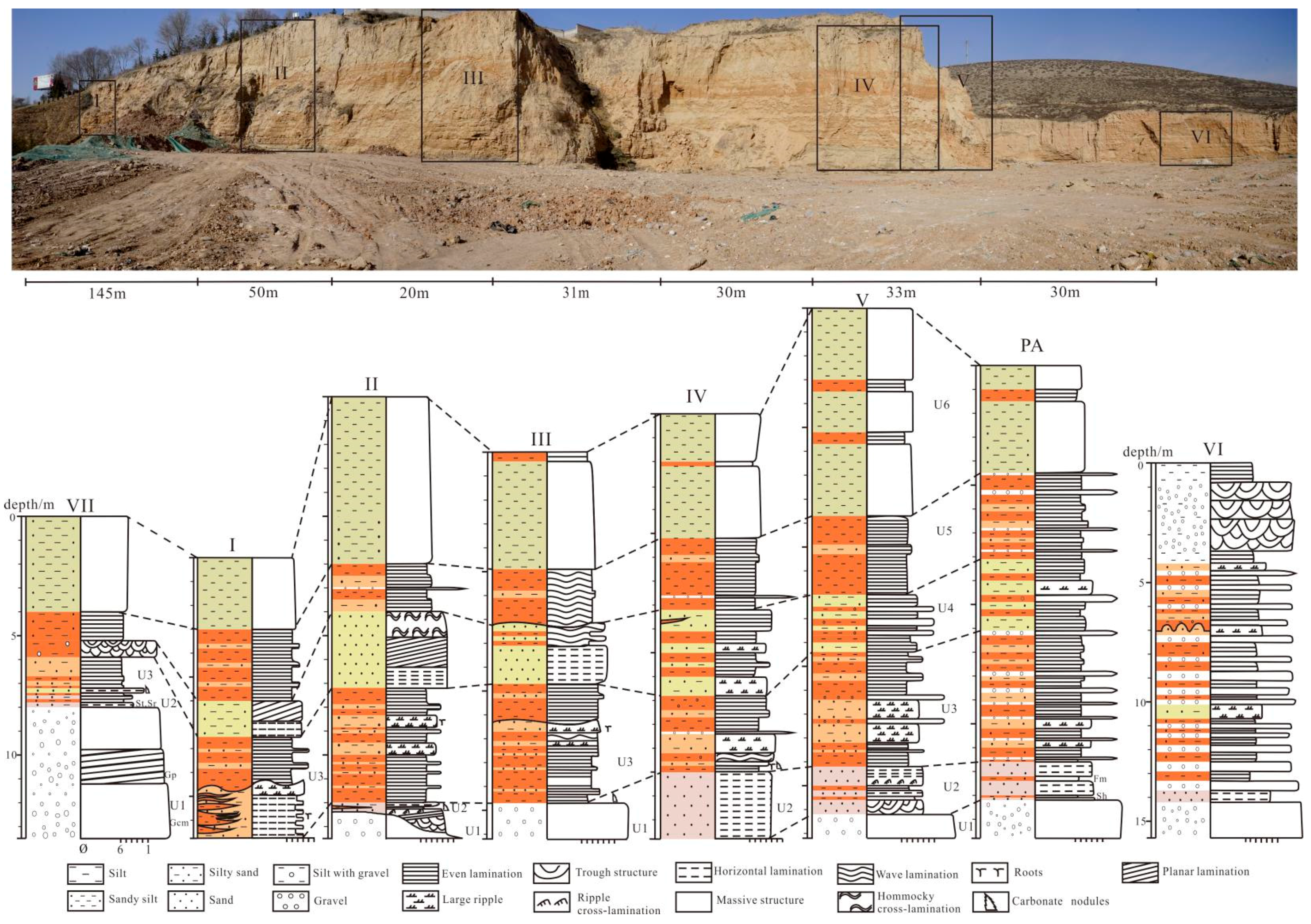
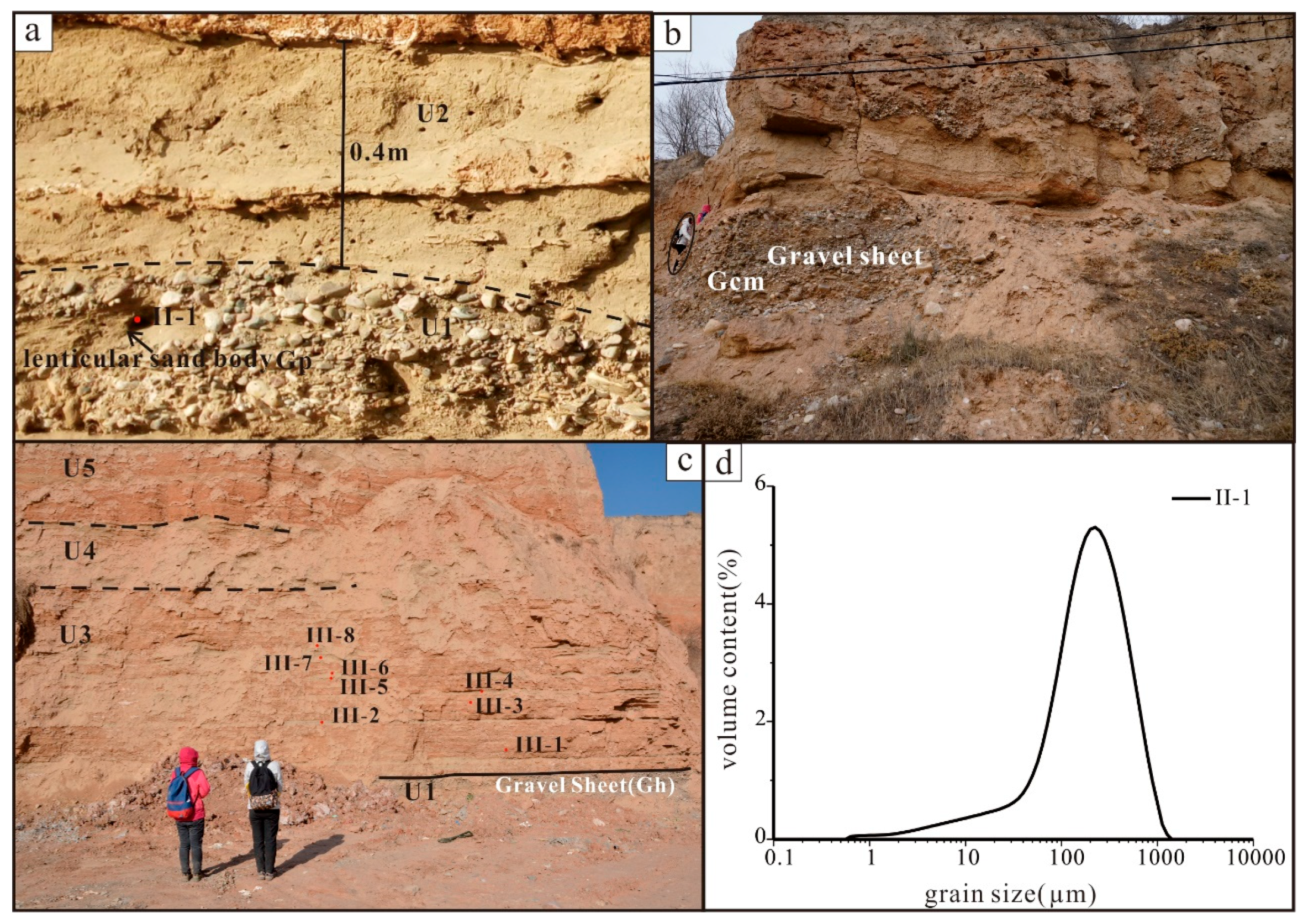

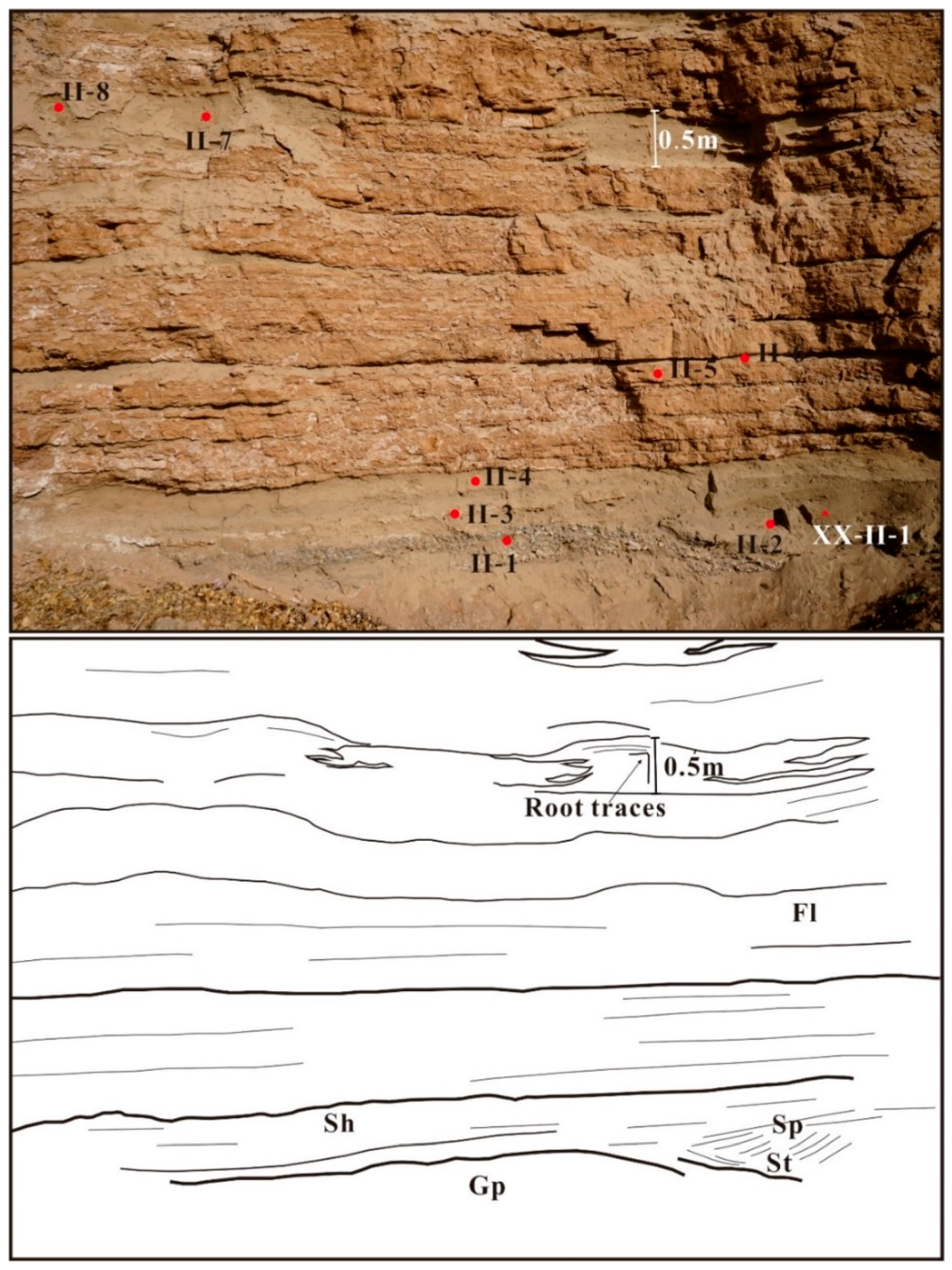
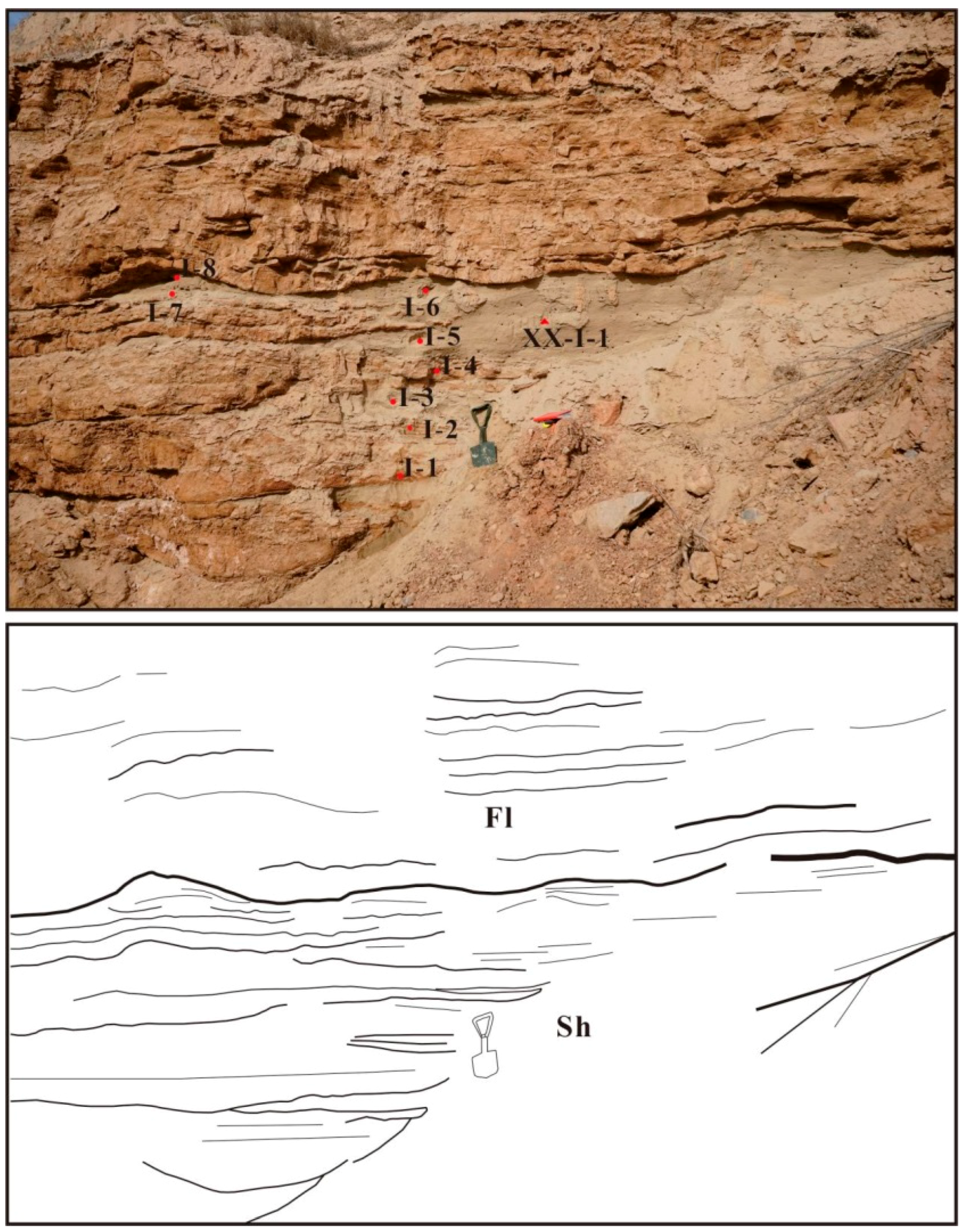
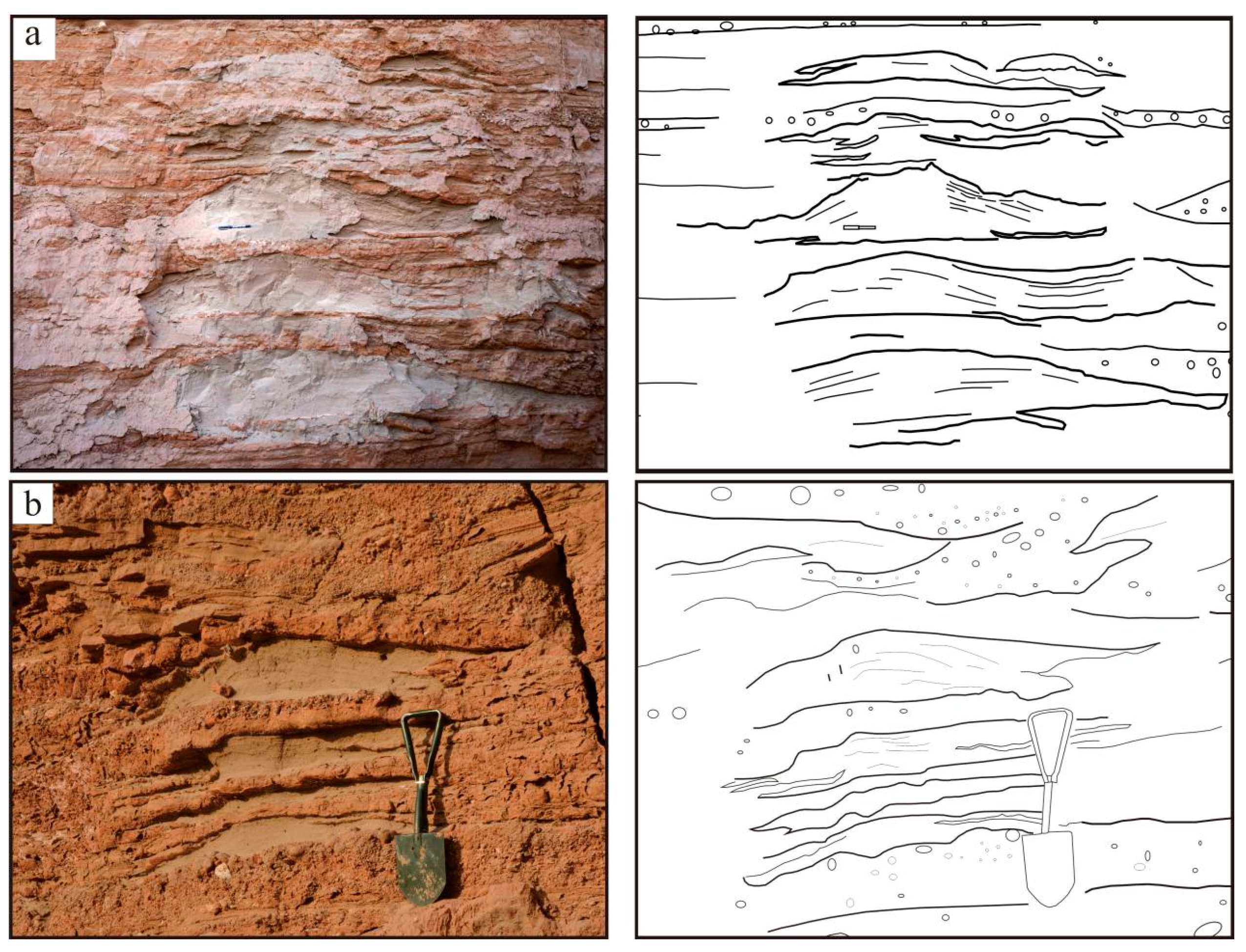
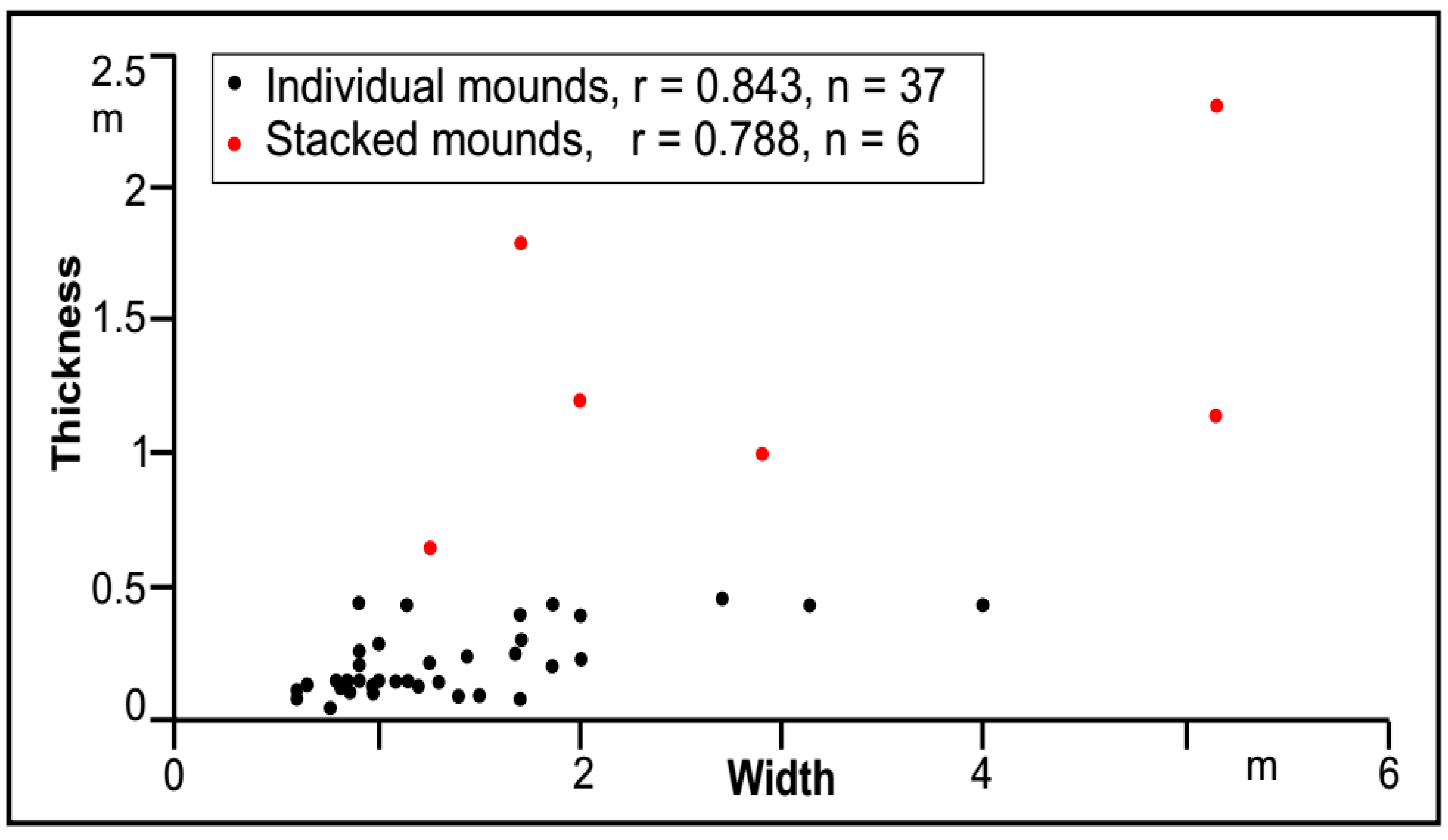
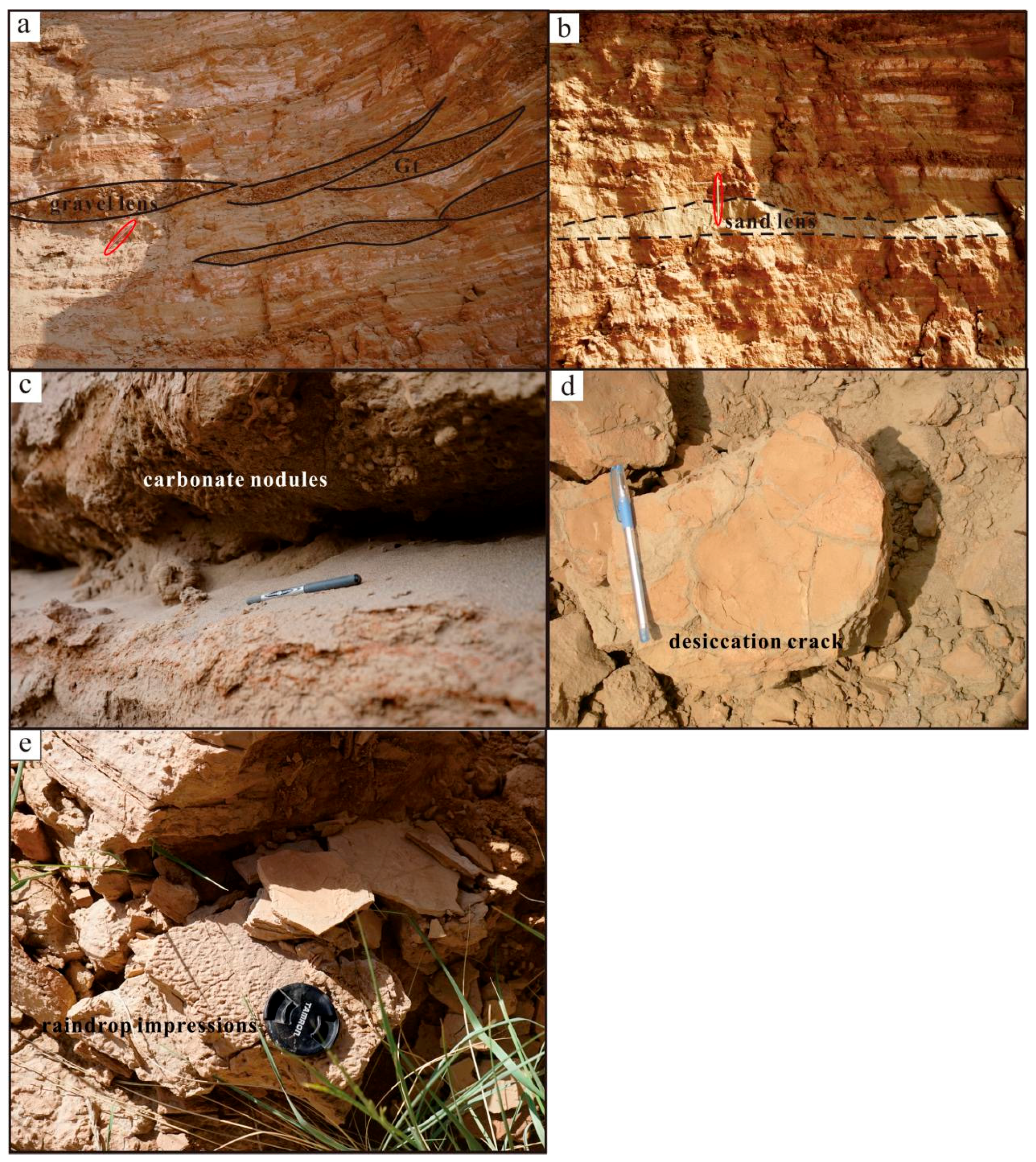
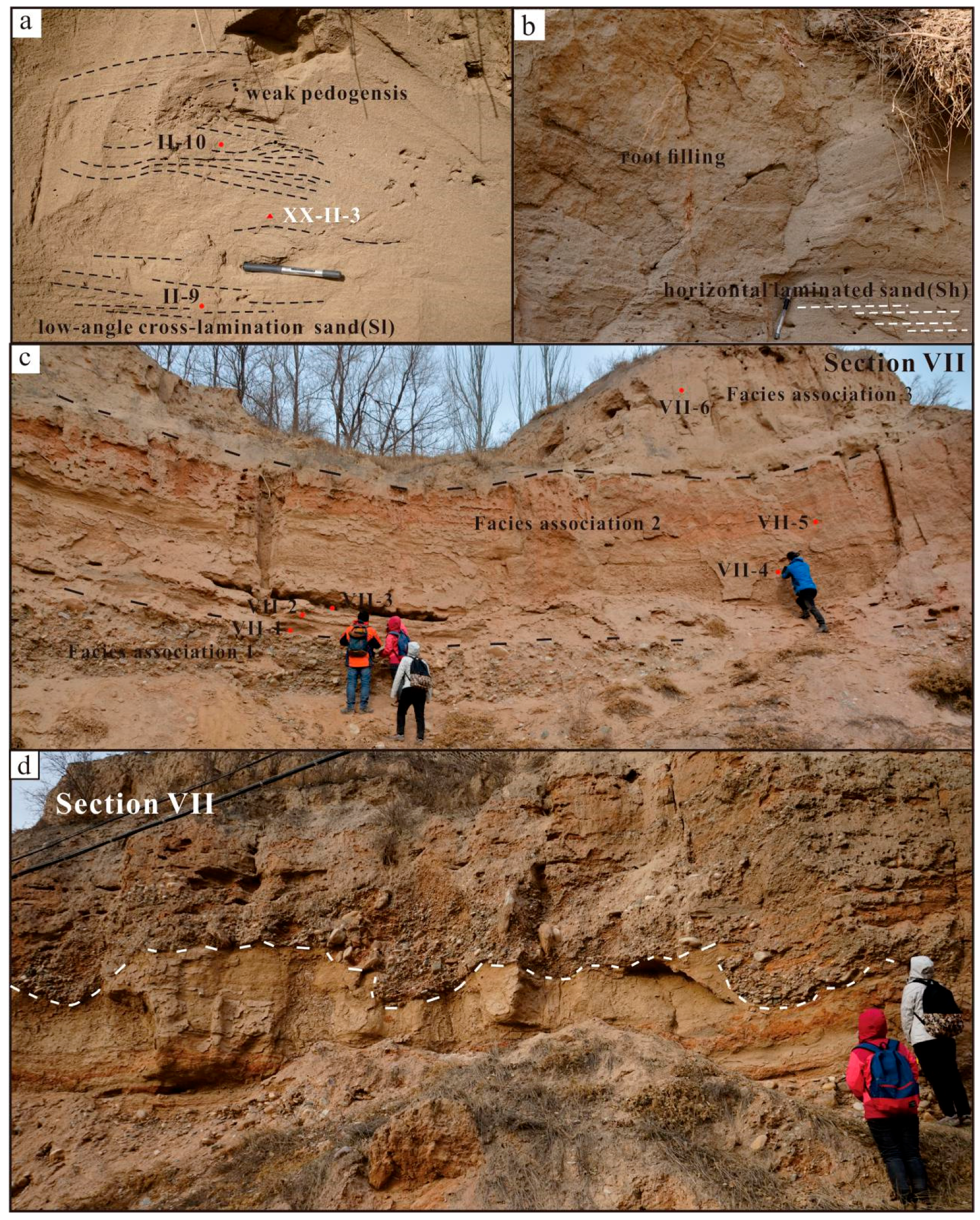
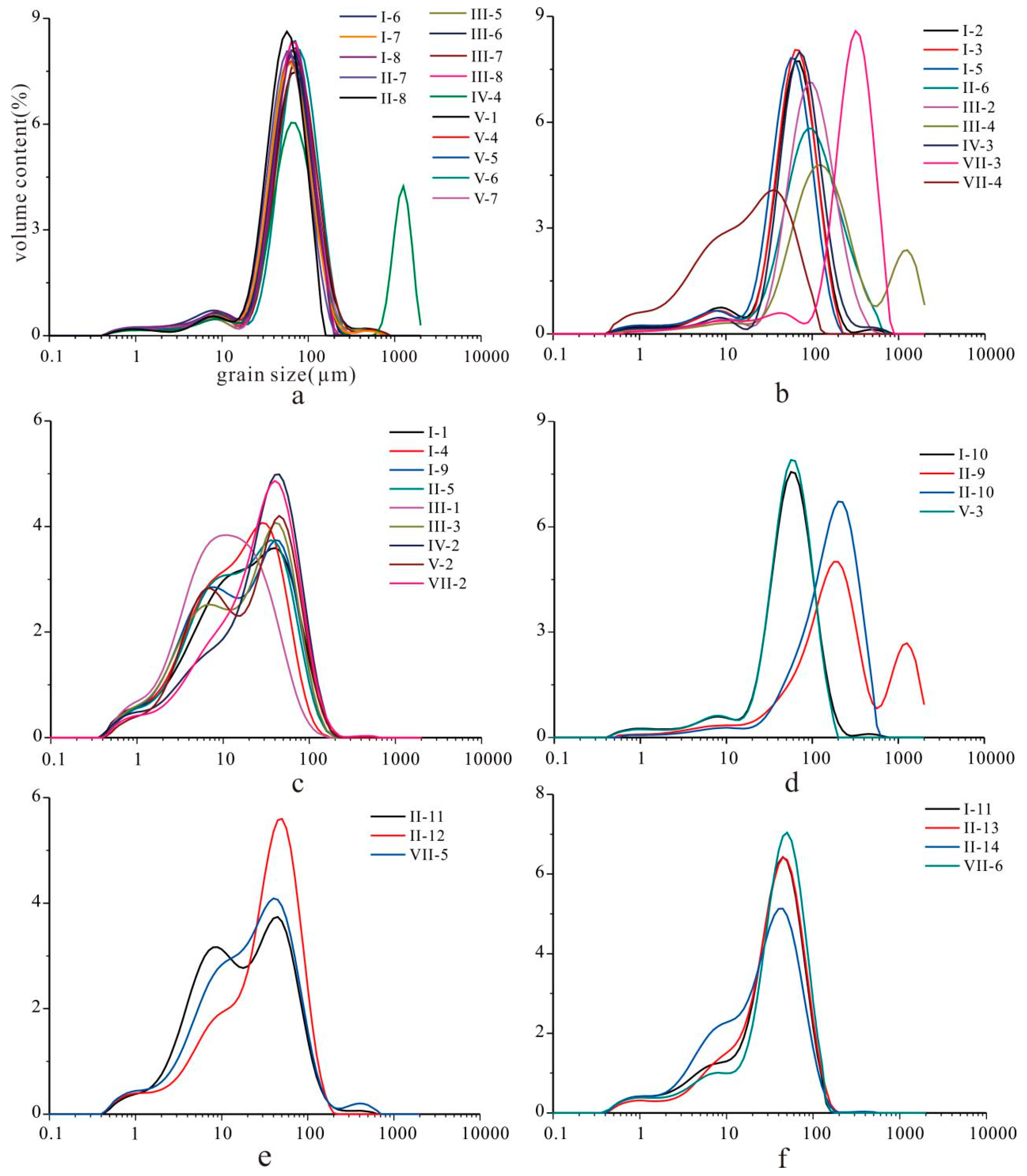
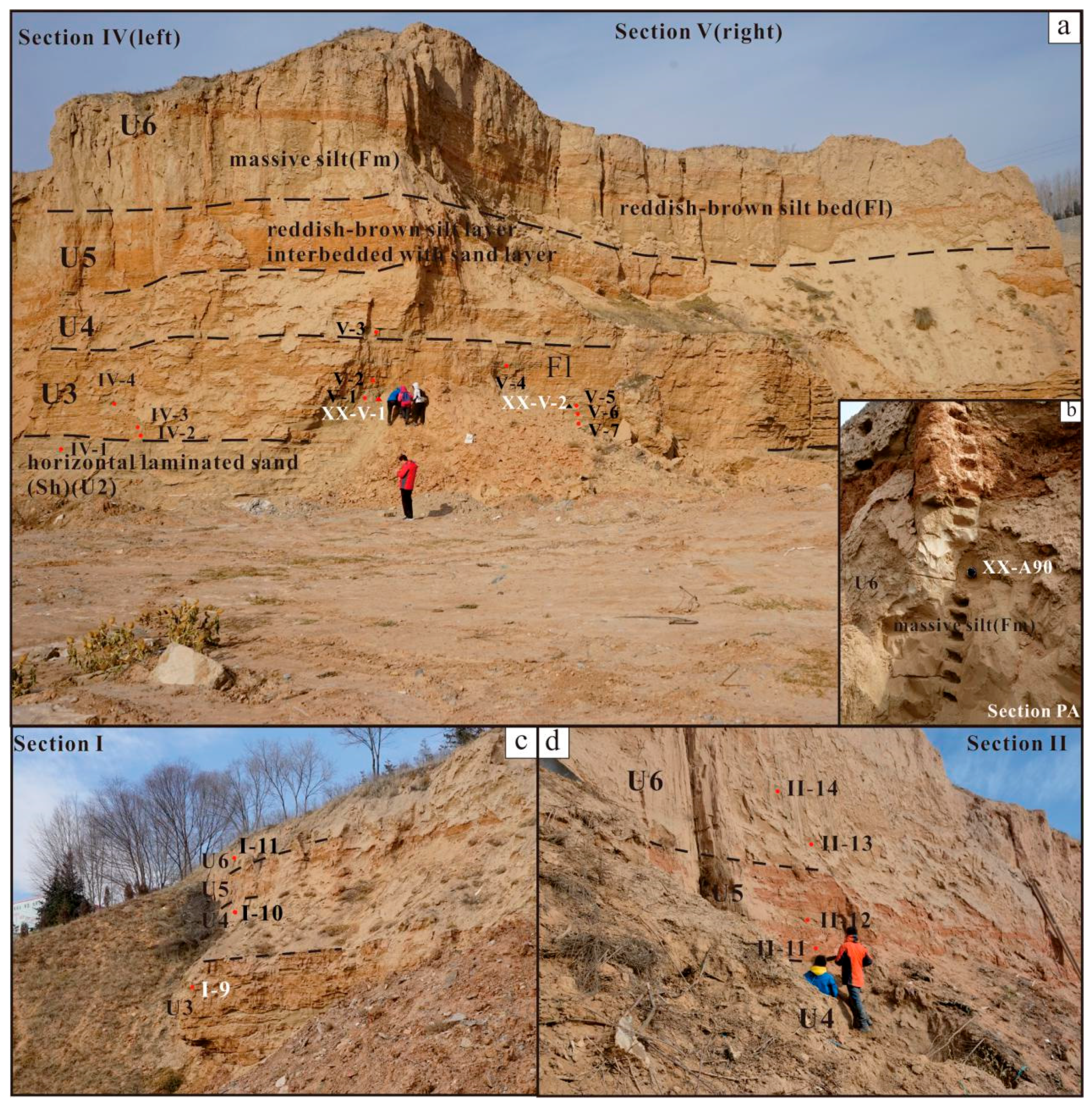

| Facies Codes | Description | Interpretation |
|---|---|---|
| Gmm | Granules and pebbles, matrix-supported, granule-sand matrix, massive, poorly sorted, tabular-or lenticular-shaped, sub-rounded to rounded | Mass-flow deposition of hyper-concentrated or turbulent flow |
| Gcm | Granules and pebbles, clast-supported, massive, poorly sorted, sub-rounded to rounded | Rapid deposition by streamflow with concentrated clasts |
| Gh | Granules and pebbles, clast-supported, crudely horizontal beds, sub-rounded to rounded | Deposition of hyperconcentrated flow in unconfined sheet flood |
| Gp | Granules and pebbles, planar cross-beds, weak imbrication, tabular-shaped, sub-rounded to rounded | Transverse 2-D gravel bedforms |
| Gt | Granules and pebbles, trough cross-stratified, sub-angular to rounded, lenticular units | Minor channel fills with deposition from 3-D gravel dunes |
| Sh | Very fine to-coarse-grained sand, horizontal lamination | Deposition of planar bed flows in channels, or sheet flood, upper flow regime |
| Sp | Very fine-to-coarse-grained sand, planar cross-lamination | Migration of two-dimensional (2-D) dunes in channel |
| Sl | Very fine-to-very coarse-grained sand, low-angle (<15°) cross-lamination | Deposition of antidunes in upper flow regime |
| St | Very fine-to-coarse-grained sand, solitary or grouped trough cross-beds | Migration of sandy ripples/dunes in channels; or filling of scour hollows or channel pools |
| Sr | Very fine-to-coarse-grained sand with ripple cross-lamination, thinly bedded | Migration of ripples in shallow channels in lower flow regime; overland sheetflows |
| Sm | Very fine-to-coarse-grained sand, structureless | Rapid deposition of sand |
| Fl | Silt, fine lamination, very small ripple sets. Occasional lenses of granules and pebbles, calcareous cement and iron-manganese coating, mottled | Waning flood deposits or overbank, abandoned channel deposits |
| Fm | Silt, structureless, desiccation cracks. Occasionally calcareous cement and iron-manganese coating, bioturbation, mottled | Suspension deposits of waning flows in overbank or abandoned channel, weak pedogenesis |
| Fr | Silt, massive, roots, bioturbation | Root bed, weak pedogenesis |
| Sample | Sediment Type |
|---|---|
| Unit 1 | |
| II-1 | Lenticular sand body |
| Unit 2 | |
| XX-II-1 II-2 | Trough cross-stratified sand |
| II-3 | Silt layer |
| XX-C490, XX-C600, XX-VI-1 II-4; IV-1; VII-1 | Horizontally laminated sand |
| Unit 3 | |
| XX-I-1, XX-II-2, XX-V-1, XX-V-2 I-6, 7, 8; II-7, 8; III-5, 6, 7, 8; IV-4; V-4, 5, 6, 7 | Sand mounds |
| I-2, 4, 9; II-5; III-1, 3; IV-2; V-2; VII-2 | Silt layers |
| XX-C200 I-1, 3, 5; II-6; III-2, 4; IV-3; VII-3, 4 | Sand to silty sand layers |
| Unit 4 | |
| XX-II-3 | Planar cross-bedded sand |
| I-10; II-9, 10; V-3 | Sand layers |
| Unit 5 | |
| XX-B100 I-11; II-12 | Sandy silt layers |
| II-11; VII-5 | Silt layers |
| Unit 6 | |
| XX-A90, XX-A220 | Structureless silt |
| I-11; II-13, 14; VII-6 | Silt and sandy silt layers |
| Lab Code | Sample Code | Sediment Units | Depth (m) | U (ppm) | Th (ppm) | K (%) | W.C. (%) | Q-Dose Rate (Gy/ka) | FK-Dose Rate (Gy/ka) | Q-De (Gy) | FK-De (Gy) | Aliquots (N) | Q-Age (ka) | FK-Age (ka) |
|---|---|---|---|---|---|---|---|---|---|---|---|---|---|---|
| Nju-2579 | XX-A90 | U6 | 1.90 | 3.18 ± 0.04 | 11.70 ± 0.03 | 1.76 ± 0.03 | 16 | 3.15 ± 0.15 | 3.47 ± 0.15 | 226 ± 13 | 454 ± 9 | 6 1/6 2 | 72 ± 5 | 131 ± 7 |
| Nju-2580 | XX-A220 | U6 | 3.20 | 3.02 ± 0.04 | 11.40 ± 0.03 | 1.68 ± 0.03 | 20 | 2.91 ± 0.13 | 3.23 ± 0.14 | 267 ± 9 | 435 ± 25 | 9 1/6 2 | 92 ± 6 | 135 ± 10 |
| Nju-2582 | XX-B100 | U5 | 5.60 | 3.04 ± 0.04 | 11.30 ± 0.03 | 1.86 ± 0.03 | 20 | 2.97 ± 0.14 | 258 ± 11 | 8 1 | 87 ± 6 | |||
| Nju-2703 | XX-II-3 | U4 | 10.50 | 2.26 ± 0.04 | 9.06 ± 0.03 | 1.55 ± 0.03 | 17 | 2.46 ± 0.12 | 2.79 ± 0.12 | 218 ± 9 | 373 ± 11 | 14 1/7 2 | 89 ± 6 | 134 ± 8 |
| Nju-2700 | XX-I-1 | U3 | 7.45 | 2.80 ± 0.04 | 10.30 ± 0.03 | 1.66 ± 0.03 | 19 | 3.03 ± 0.13 | 433 ± 8 | 10 2 | 143 ± 7 | |||
| Nju-2583 | XX-C200 | U3 | 14.00 | 3.06 ± 0.04 | 11.70 ± 0.03 | 1.61 ± 0.03 | 17 | 2.78 ± 0.14 | 231 ± 8 | 16 1 | 83 ± 5 | |||
| Nju-2702 | XX-II-2 | U3 | 14.30 | 3.02 ± 0.04 | 11.00 ± 0.03 | 1.71 ± 0.03 | 21 | 2.72 ± 0.13 | 3.06 ± 0.13 | 203 ± 7 | 401 ± 8 | 16 1/4 2 | 74 ± 4 | 131 ± 7 |
| Nju-2704 | XX-V-1 | U3 | 15.60 | 3.08 ± 0.04 | 11.40 ± 0.03 | 1.65 ± 0.03 | 20 | 2.72 ± 0.13 | 3.06 ± 0.13 | 225 ± 12 | 406 ± 9 | 14 1/6 2 | 83 ± 6 | 133 ± 7 |
| Nju-2705 | XX-V-2 | U3 | 18.40 | 2.53 ± 0.04 | 10.20 ± 0.03 | 1.75 ± 0.03 | 20 | 2.97 ± 0.13 | 416 ± 13 | 6 2 | 140 ± 8 | |||
| Nju-2706 | XX-VI-1 | U2 | 14.00 | 2.41 ± 0.04 | 10.70 ± 0.03 | 1.50 ± 0.03 | 15 | 2.90 ± 0.13 | 458 ± 16 | 6 2 | 158 ± 10 | |||
| Nju-2585 | XX-C490 | U2 | 16.90 | 2.77 ± 0.04 | 10.70 ± 0.03 | 1.76 ± 0.03 | 15 | 2.86 ± 0.14 | 232 ± 12 | 16 1 | 81 ± 6 | |||
| Nju-2586 | XX-C600 | U2 | 18.00 | 2.15 ± 0.04 | 9.95 ± 0.03 | 1.55 ± 0.03 | 14 | 2.53 ± 0.13 | 218 ± 9 | 8 1 | 86 ± 6 | |||
| Nju-2701 | XX-II-1 | U2 | 18.00 | 2.16 ± 0.04 | 9.50 ± 0.03 | 1.67 ± 0.04 | 15 | 2.64 ± 0.13 | 2.97 ± 0.14 | 204 ± 11 | 395 ± 6 | 13 1/6 2 | 78 ± 6 | 133 ± 7 |
© 2018 by the authors. Licensee MDPI, Basel, Switzerland. This article is an open access article distributed under the terms and conditions of the Creative Commons Attribution (CC BY) license (http://creativecommons.org/licenses/by/4.0/).
Share and Cite
Gao, L.; Wang, X.; Yi, S.; Vandenberghe, J.; Gibling, M.R.; Lu, H. Episodic Sedimentary Evolution of an Alluvial Fan (Huangshui Catchment, NE Tibetan Plateau). Quaternary 2018, 1, 16. https://0-doi-org.brum.beds.ac.uk/10.3390/quat1020016
Gao L, Wang X, Yi S, Vandenberghe J, Gibling MR, Lu H. Episodic Sedimentary Evolution of an Alluvial Fan (Huangshui Catchment, NE Tibetan Plateau). Quaternary. 2018; 1(2):16. https://0-doi-org.brum.beds.ac.uk/10.3390/quat1020016
Chicago/Turabian StyleGao, Linman, Xianyan Wang, Shuangwen Yi, Jef Vandenberghe, Martin R. Gibling, and Huayu Lu. 2018. "Episodic Sedimentary Evolution of an Alluvial Fan (Huangshui Catchment, NE Tibetan Plateau)" Quaternary 1, no. 2: 16. https://0-doi-org.brum.beds.ac.uk/10.3390/quat1020016






